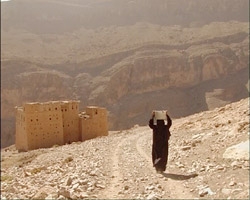
By Alistair Lyon, Special Correspondent, Environmental News Network, March 1, 2008
BEIT HUJAIRA, Yemen (Reuters) – Black-clad women trudge across a stony plateau in the Yemeni highlands to haul water in yellow plastic cans from wells that will soon dry up.
“We come here three or four times a day,” says Adiba Sena, as another woman draws water six metres (20 feet) to the surface and pours it into jerry cans lashed to her grey donkey. “We use it to clean, cook, wash — we have no pipes that reach us.”
These women are at the sharp end of what Yemen’s water and environment minister describes as a collapse of national water resources so severe it cannot be reversed, only delayed at best.
“This is almost inevitable because of the geography and climate of Yemen, coupled with uncontrolled population growth and very low capacity for managing resources,” the minister, Abdul-Rahman al-Iryani, told Reuters in an interview.
Yemen relies on groundwater, which nature cannot recharge fast enough to keep pace with a population of 22.4 million expanding by more than 3 percent a year.
More water is being consumed than resupplied to 19 of the impoverished country’s 21 aquifers, Iryani said.
Wells and cisterns in villages like Beit Hujaira fill during short rainy seasons and gradually run dry as water is consumed or evaporates. “Then we die of thirst,” Sena said.
In fact, villagers are forced to pay for trucks or pickups which struggle up rocky tracks with precious drinking water.
COLLAPSING BASINS
“We have nothing, God help us,” fumed Husseina al-Qabri, 45, who is weary of her daily forays to the well. “We want water, electricity, a school. I want to learn to read.”
Beit Hujaira lies in the water basin of Amran, a parched province just north of Sanaa, the capital.
“Amran and Sanaa are probably very close to collapse,” said Ramon Scoble, team leader of an Amran water project run by the German aid agency GTZ.
“Saada in the far north may be next in line. Further south, the basin in Taiz collapsed almost 10 years ago and people have been relying on renewable resources,” he said, meaning fresh rainfall as opposed to water stored in the ground.
Staving off disaster on this scale would challenge even a richer nation. For Yemen, where 45 percent of the population survives on less than $2 a day, the odds are much worse.
Nearly 75 percent of Yemenis still live in the countryside, but an accelerating drift to the cities has overwhelmed urban utilities, including water. Sanaa has mushroomed to more than 2 million people from just 60,000 in the 1940s.
“The deepest wells in Sanaa are now 1,000 metres — you need an oil drilling rig to get that deep — and water levels are dropping 6 to 12 to 20 metres a year,” Scoble said.
Yemen uses about 90 percent of its water to irrigate qat, a mild narcotic plant whose use dominates Yemeni society.
The area under qat cultivation is growing 10 to 15 percent a year, Iryani said, adding that efforts to make irrigation more efficient were hamstrung by a huge government fuel subsidy that masks the true cost of water, spurring qat farmers to pump more.
“Farmers have no incentive to invest in modern irrigation techniques. Diesel is so cheap they don’t need to save water, and the return from qat is so high.”
Iryani said the government could not enforce water drilling and irrigation laws on major consumers such as tribal chiefs, military officers and rich people even if it tried. He said 99 percent of water drilling is unlicensed.
“Regarding water, we don’t have the will or the means,” he said. “The worst abusers of the system are the big shots, the people with power.” He reckoned the government’s best chance was to foster a social consensus on how to tackle the crisis.
ARABIA FELIX?
Yemen was long envied for its rainfall, terraced fields and irrigation channels. The Romans called it Arabia Felix, a name that mocks the unhappy modern reality of water scarcity.
Desalinating sea water would be costly for an inland city like Sanaa, perched 2,200 metres (7,200 feet) above sea level, with higher peaks barring any pipeline route from the Red Sea.
Millions of people might eventually have to move from arid highland cities to Yemen’s Tihama coastal plain, which has more water potential, but is also hot, humid and prone to malaria.
Even now, 40 percent of Yemeni city households are not linked to water mains and two thirds lack proper sanitation, according to a GTZ document. It describes Yemen’s water shortage as one of the greatest worldwide, saying groundwater reservoirs have been polluted and over-exploited for more than two decades.
Unless Yemen confronts its population explosion head-on, nothing will improve, said Scoble, the water expert in Amran.
“Maybe this generation could limit Yemen’s population to 28 or 30 million if they were really aggressive,” he said.
“But they would have to pump in immense amounts of money. You are not coming to an educated, literate, savvy population, but to predominantly illiterate, male-dominated households where both religion and culture see large numbers of sons as great.”
The women lugging water in Beit Hujaira are victims of the worsening water crunch. Qabri said she had kidney problems, a complaint shared by many in the village and in Yemen generally.
“There are people aged 20 with kidney stones because they simply don’t drink enough water,” said Scoble.